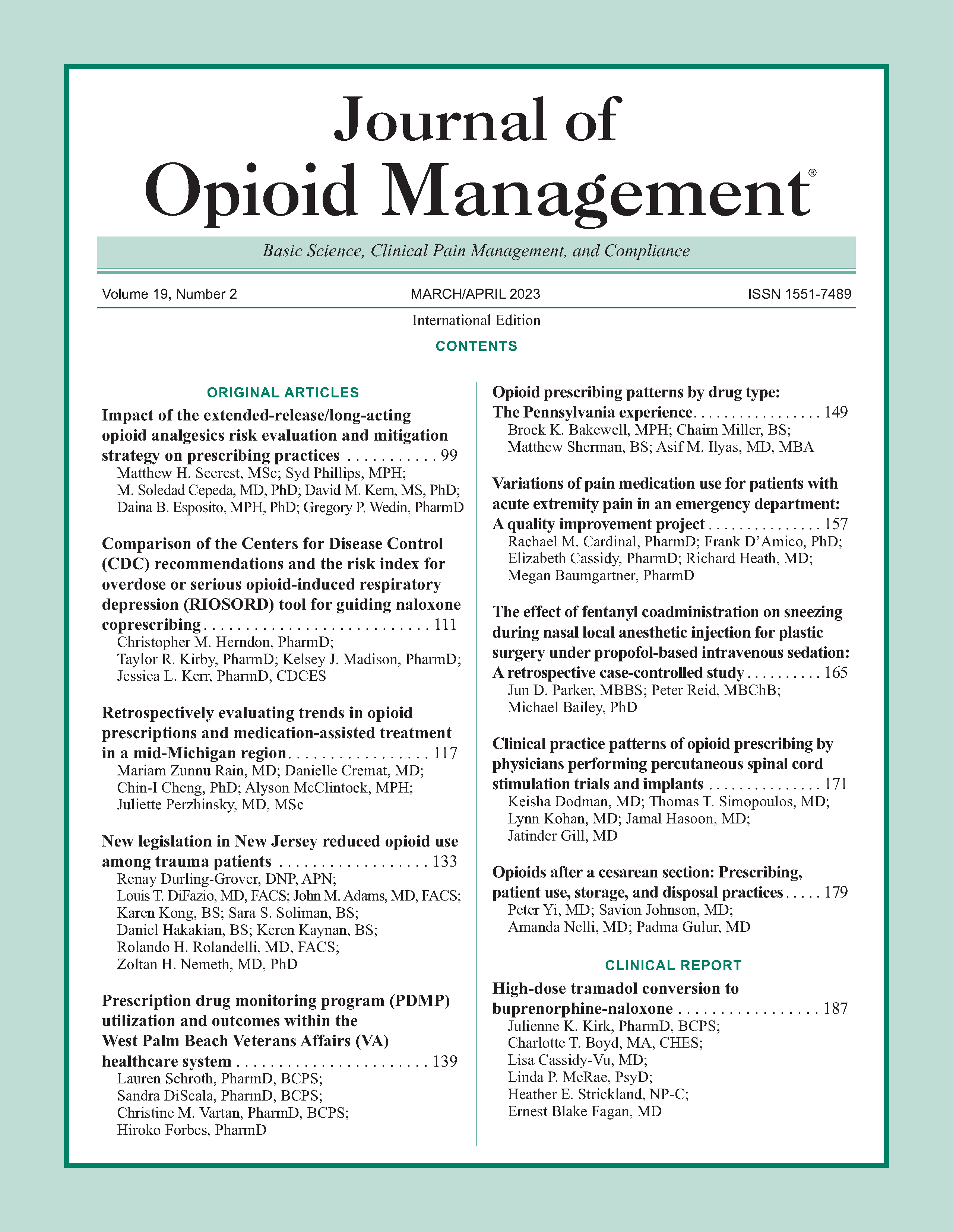Retrospectively evaluating trends in opioid prescriptions and medication-assisted treatment in a mid-Michigan region
DOI:
https://doi.org/10.5055/jom.2023.0766Keywords:
opioid, medication-assisted treatment, chronic pain, opioid monitoringAbstract
Objective: To evaluate opioid prescribing and monitoring trends for musculoskeletal (MSK) conditions and the use of medication-assisted treatment (MAT) for opioid-related disorders in mid-Michigan.
Design: Retrospective chart review of 500 randomly selected charts coded for MSK conditions and opioid-related disorders based on the 10th revision of the International Statistical Classification of Diseases and Related Health Problems (ICD-10) codes during the time frame of January 1 to June 30, 2019. Data were compared to baseline data collected in a previous 2016 study to evaluate prescribing trends.
Setting: Outpatient clinics and emergency departments.
Main outcome measures: Variables included prescription of opioid, nonopioid, use of prescription monitoring such as assessing urine drug screens (UDSs), a Prescription Drug Monitoring Program (PDMP), pain agreements, prescription of MAT, and sociodemographic factors.
Results: 31.3 percent of patients in 2019 had a new or current opioid prescription, which is a significant decrease compared to opioid prescriptions in 2016 (65.7 percent) (p = 0.001). Monitoring of opioid prescribing using PDMP and pain agreements increased, whereas UDS monitoring remained low. MAT prescribing for patients with opioid use disorder in 2019 was 31.4 percent. State-sponsored insurance was associated with a higher odds of using PDMP and pain agreements with an odds ratio (OR) of 1.72 (0.97, 3.13), while alcohol misuse had a lower odds of using PDMP (OR 0.40).
Conclusion: Opioid prescribing guidelines have been effective in reducing opioid prescribing and increasing opioid prescription monitoring. MAT prescribing is low in 2019 and does not reflect a declining trend of opioid prescriptions during a public health crisis.
References
US Department of Health and Human Services: HHS acting secretary declares public health emergency to address national opioid crisis. Available at http://www.hhs.gov/about/news/2017/10/26/hhs-acting-secretary-declares-public-healthemergency-address-national-opioid-crisis.html. Accessed January 21, 2020.
Scholl L, Seth P, Kariisa M, et al.: Drug and opioid-involved overdose deaths—United States, 2013–2017. MMWR Morb Mortal Wkly Rep. 2019; 67: 1419-1427.
Mattson CL, Tanz LJ, Quinn K, et al.: Trends and geographic patterns in drug and synthetic opioid overdose deaths—United States, 2013-2019. MMWR Morb Mortal Wkly Rep. 2021; 70: 202-207.
Bohnert A, Erb-Downward J, Ivacko T: Opioid Addiction: Meeting the Need for Treatment in Michigan. Michigan: Poverty Solutions University of Michigan, 2019.
Dowell D, Haegerich TM, Chou R: CDC guideline for prescribing opioids for chronic pain—United States, 2016. MMWR Recomm Rep. 2016; 65(1): 1-49.
National Institutes of Health: HEAL initiative research plan. Available at https://www.nih.gov/research-training/medicalresearch-initiatives/heal-initiative/heal-initiative-researchplan. Accessed January 21, 2020.
Andrilla CHA, Coulthard C, Patterson DG: Prescribing practices of rural physicians waivered to prescribe buprenorphine. Amer J Prev Med. 2018; 54(6, Suppl 3): S208–S214.
Bart G: Maintenance medication for opiate addiction: The foundation of recovery. J Addict Dis. 2012; 31(3): 207-225.
Pierce DP, Pierce B, Cheng CI, et al.: Assessing treatment and monitoring of musculoskeletal conditions using opioid versus nonopioid therapy. Medicine. 2019; 98(15): e15128.
Lewis MJ: Established aggregate production quotas for schedule I and II controlled substances. The Daily Journal of the United States Government. October 5, 2016.
American Medical Association: Issue brief: Nation’s drug-related overdose and death epidemic continues to worsen. 2021. Available at https://www.ama-assn.org/system/files/issuebriefincreases-in-opioid-related-overdose.pdf. Accessed December 2, 2021.
Centers for Disease Control and Prevention: Alcohol use and your health. Available at http://www.cdc.gov/alcohol/fact-sheets/alcohol-use.htm. Accessed December 14, 2021.
Lin DH, Jones CM, Compton WM, et al.: Prescription drug coverage for treatment of low back pain among US Medicaid, Medicare advantage, and commercial insurers. JAMA Netw Open. 2018; 1(2): e180235.
Häuser W, Bernardy K, Arnold B, et al.: Efficacy of multicomponent treatment in fibromyalgia syndrome: A meta-analysis of randomized controlled clinical trials. Arthritis Rheum. 2009; 61(2): 216-224.
Cherkin DC, Sherman KJ, Balderson BH, et al.: Effect of mindfulness-based stress reduction vs cognitive behavioral therapy or usual care on back pain and functional limitations in adults with chronic low back pain: A randomized clinical trial. JAMA. 2016; 315(12): 1240-1249.
Geneen LJ, Moore RA, Clarke C, et al.: Physical activity and exercise for chronic pain in adults: An overview of Cochrane reviews. Cochrane Database Syst Rev. 2017; 1(1): CD011279.
Reinecke H, Weber C, Lange K, et al.: Analgesic efficacy of opioids in chronic pain: Recent meta-analyses. Br J Pharmacol. 2015; 172(2): 324-333.
Ives TJ, Chelminski PR, Hammett-Stabler CA, et al.: Predictors of opioid misuse in patients with chronic pain: A prospective cohort study. BMC Health Serv Res. 2006; 6(1): 46.
Rice JB, White AG, Birnbaum HG, et al.: A model to identify patients at risk for prescription opioid abuse, dependence, and misuse. Pain Med. 2012; 13(9): 1162-1173.
White AG, Birnbaum HG, Schiller M, et al.: Analytic models to identify patients at risk for prescription opioid abuse. Am J Manag Care. 2009; 15(12): 897-906.
Yoon JH, Lane SD, Weaver MF: Opioid analgesics and nicotine: More than blowing smoke [abstract]. J Pain Palliat Care Pharmacother. 2015; 29(3): 281-289.
Ostrach B, Potter R, Wilson CG, et al.: Ensuring buprenorphine access in rural community pharmacies to prevent overdoses. J Am Pharm Assoc. 2022; 62(2): 588-597.e2.
Office of Inspector General Data Brief: Opioid use in Medicare Part D continued to decline in 2019, but Vigilance is needed as COVID-19 raises new concerns. Available at https://oig.hhs.gov/oei/reports/OEI-02-20-00320.pdf. Accessed December 7, 2021.
Andrilla CHA, Patterson DG: Tracking the geographic distribution and growth of clinicians with a DEA waiver to prescribe buprenorphine to treat opioid use disorder. J Rural Health. 2021. DOI: 10.1111/jrh.12569.
Dowell D, Haegerich TM: Changing the conversation about opioid tapering. Ann Intern Med. 2017; 167(3): 208-209.
Dowell D, Haegerich T, Chou R: No shortcuts to safer opioid prescribing. N Engl J Med. 2019; 380(24): 2285-2287.
Centers for Disease Control and Prevention: Drug overdose deaths. Available at https://www.cdc.gov/drugoverdose/deaths/index.html. Accessed December 7, 2021.
Published
How to Cite
Issue
Section
License
Copyright 2005-2025, Weston Medical Publishing, LLC and Journal of Opioid Management. All Rights Reserved.











